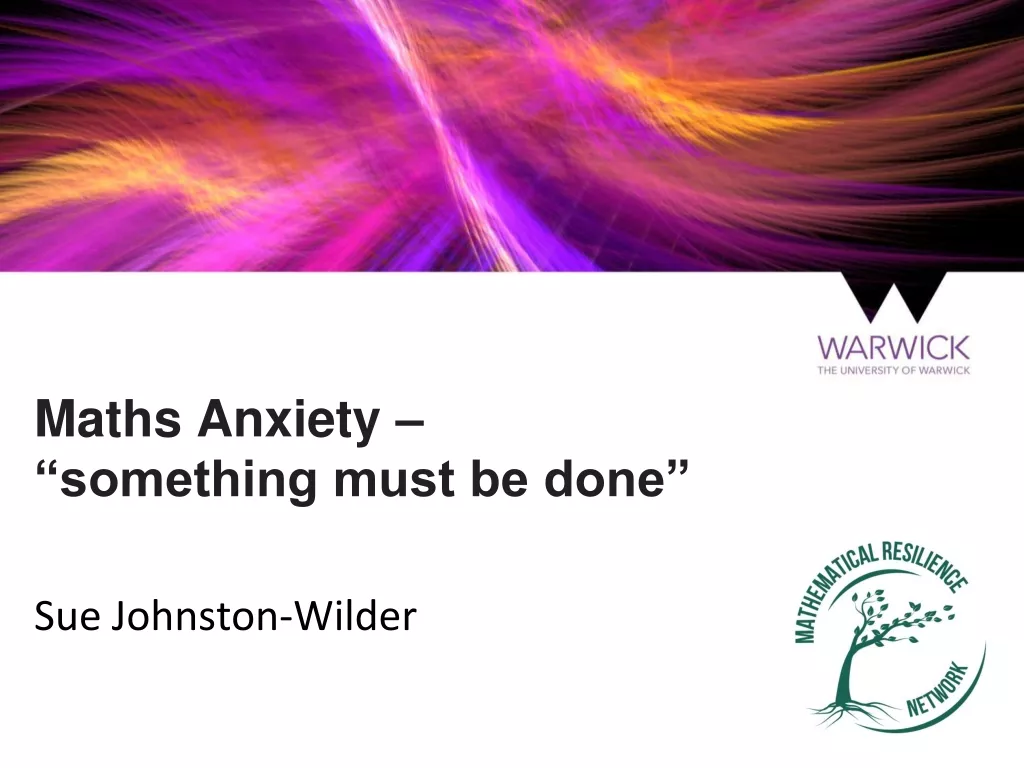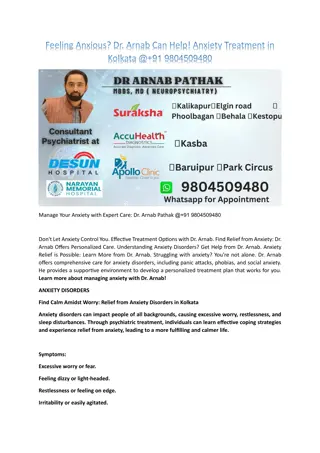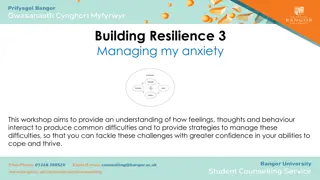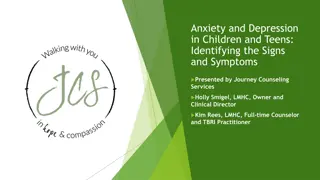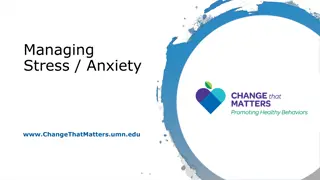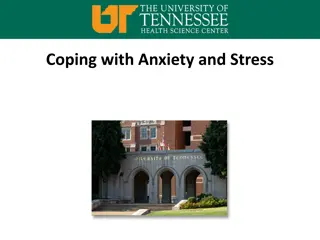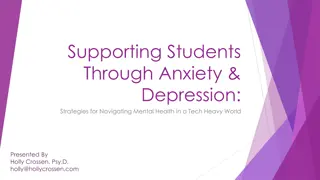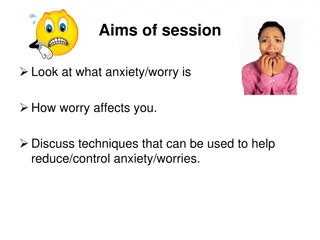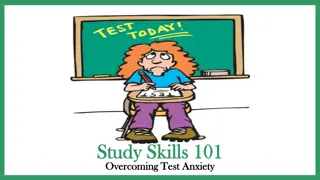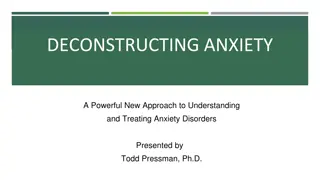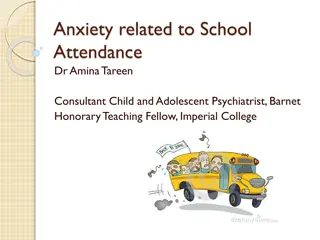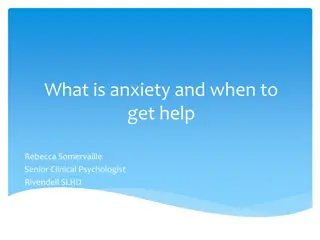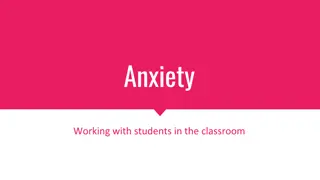Understanding Anxiety: Types, Differences, and Impacts
Anxiety is a common emotional response characterized by feelings of worry, nervousness, and unease. This content delves into the various types of anxiety, compares fear to anxiety, explores the distinctions between anxiety and stress, discusses the inevitability and normalcy of anxiety, and highlights the impact of excessive anxiety on mental health, particularly in children. It emphasizes the importance of recognizing and addressing anxiety, considering factors such as genetic predispositions and environmental influences.
Download Presentation

Please find below an Image/Link to download the presentation.
The content on the website is provided AS IS for your information and personal use only. It may not be sold, licensed, or shared on other websites without obtaining consent from the author. Download presentation by click this link. If you encounter any issues during the download, it is possible that the publisher has removed the file from their server.
E N D
Presentation Transcript
Take a minute to answer this question What is anxiety? What words do you use to describe anxiety?
Fear VS Anxiety Fear an unpleasant emotion caused by the belief that someone or something is dangerous, likely to cause pain, or a threat. . https://www.youtube.com/watch?v=AV6rhYssCQM
Anxiety VS Stress Stress is your body's way of responding to any kind of demand or threat. When you sense danger whether it's real or imagined the body's defenses kick into high gear in a rapid, automatic process known as the fight-or- flight reaction or the "stress response." https://www.youtube.com/watch?v=S8-zfk9_lhg
Anxiety Anxiety anxius [L, 1500s], a condition of agitation and distress -- internal focus -- a response to a vague, distant or even unrecognized danger a feeling of worry, nervousness, or unease, typically about an imminent event or something with an uncertain outcome
Anxiety Anxiety: - inevitable - response to everyday challenge - proportioned, *appropriate, *reasonable Anxiety is normal!
Some statistics At least 20% of children under age 18 have significant mental health problems. 75% of those don t get help.
Too much anxiety is unhealthy. Often there is a family (genetic) tendency to anxiety Stress can be in family, school or neighborhood Anxious parents can model anxious behavior for children Children who live with too much stress can develop anxiety disorders
Dimensions of Anxiety: Symptoms in four arenas Somatic - Hyperventilation - Tachycardia - trembling - shakiness - sweating - flushing -nausea - dizziness - wobbling legs - palpitations - swallowing - lump in throat - urgency to urinate - hair raising - tinnitus
Dimensions of Anxiety: Symptoms in four arenas Cognitive - Specific fears - Embarrassment or shame is intolerable - Something awful will happen - I am going crazy - I will lose control - I am going to die
Dimensions of Anxiety: Symptoms in four arenas Behavioral Withdrawal Avoidance Escape Clinging Aggression
Dimensions of Anxiety: Symptoms in four arenas Emotional - Tense - Worried - Panicky - Terrified - Scared - Anxious - Nervous - On edge - Feelings of unreality - Hypervigilant - Depressed
When to be concerned Avoidance of school (refuses to go) Frequent stomachaches or headaches in the morning before school Avoidance of activities Easily upset distress out of proportion Parent or teacher reports they spent a lot of time comforting the child and/or urging her/him to participate in regular activities Parent or teacher reports family/classroom functioning is being disrupted by your child's fears and worries, or meltdowns. Intense worries or fears that interfere with daily activities
When to be concerned Sudden overwhelming fear for no reason, often with difficulty breathing and racing or pounding heart Decline in school performance Wanting to avoid school
Anxiety Anxiety disorders are the most common mental health disorders. Up to 6% of children and youth have an anxiety disorder severe enough to need treatment. Children may have more than one kind of anxiety disorder. Many anxiety disorders start in childhood and if untreated, they may persist into adulthood.
Anxiety Disorders Anxiety Disorders: - intensity - duration - impairment
Types of Anxiety Separation anxiety Selective mutism Specific phobia Situational Anxiety Other Social Anxiety Panic Disorder Agoraphobia Generalized anxiety disorder Substance Induced Anxiety Anxiety not due to medical condition Other specified anxiety disorders Unspecified anxiety disorder
Separation Anxiety Disorder Child is afraid of leaving their parent(s) They may worry that something bad will happen to the parent or to someone they love or to themselves May refuse to go to school May have stomachaches, headaches, or throw up if they fear separation May refuse to go to playdates at other people s houses Diagnosed if it causes problems at school or socially and has been going on at least 4 weeks https://www.youtube.com/watch?v=dRFgSpJz-K4
Generalized Anxiety Disorder Children with this kind of anxiety may: Have lots of worries and fears Have problems sleeping because of worries Have trouble concentrating Get tired easily or have tension headaches Be tense or restless Be perfectionist Have an anxious desire for approval https://www.youtube.com/watch?v=SYfvtVooPM8
Panic Disorder Happens less often with younger children People with this kind of anxiety have panic attacks Feel very scared Heart pounding, hard to breathe May feel shaky, dizzy, or sick May feel like they are going crazy or something really awful is going to happen Sometimes they avoid school or want to stay in the house Frequent panic attacks = panic disorder https://www.youtube.com/watch?v=jJH1fSfqBTs
Selective Mutism Children may not talk to anyone who is not close to them, such as immediate family They may look down, withdraw, turn red if required to talk Often they whisper if they do speak in a situation where they are anxious Up to 2% of school age children may have these symptoms Some kids outgrow it; some go on to have social phobia https://www.youtube.com/watch?v=aIrDeBoUGlE
Social Anxiety/Social Phobia Happens more in teens than in young children Fear and worry about social situations Going to school Speaking in class Social events including recess and lunch Shy, self-conscious Easily embarrassed These kids tend to be sensitive to criticism and find it hard to be assertive https://www.youtube.com/watch?v=ypHzXOcUQwE
Assessment List and clarify all symptoms Look at history: family, drug use, mental health, medical health. Analysis of current lifestyle status: stress, nutrition, exercise, sleep, medications. List problem areas. Rule out physical and other psychiatric causes, getting medical results.
Assessment Medical Rule Outs Shortness of breath Heart Respiration Dizziness Anemia, BPV, BP Numbness Circulatory respiratory Palpitations Tachycardia Thyroid Hypoglycemia Chest pain Heart conditions Autoimmune CFS Fibromyalgia Epstein-Barr
Assessment cont Drug Usage Rule Outs Alcohol Kindling Neural excitement during withdrawal Cocaine Kindling Drug-induced panic Other stimulants OTC drugs Diet pills Laxatives Caffeine aspartame Other medications Disulfiram Drugs to treat thyroid and endocrine
Treatment Anxiety disorders can be treated! The most common treatment is cognitive behavior therapy (CBT) in groups or individually In CBT children learn relaxation and stress management plus Gradual exposure to things that make them anxious, to decrease the fear Coping strategies to reduce anxiety
Treatment CBT is first choice, but medication may be needed in severe situations Teach relaxation strategies such as belly breathing and muscle relaxation Teach visualize or imagine a pleasant, relaxing happy place
Treatment Psychotherapy Subjective Rating Scales Use Explain concepts of SUDs Discuss the meaning of the ratings 0 10 No comparison to other people are ever involved, self-assessment tool No internal competition: observing only
Grounding! Look around you. Find 5 things you can see, 4 things you can touch, 2 things you can smell and 1 thing you can taste. This is called grounding It is helpful to do when you are anxious.
Daily Record of Breathing or Relaxation Time Assign- ment SUD Outset Duration SUD completion
Treatment Medication Consideration Benzodiazepines: For panic, acute anxiety symptoms To enhance early tx Short term use e.g. 30 days Daily, regular use Rarely used PRN Antidepressants Misnamed Used for chronic anxiety and depressed moods Long term use Bolster with lifestyle changes and psychotherapy
Treatment Medication Choices Benzodiazepine Sedative/ Hypnotic Antidepressants - Valium - Xanax - Librium - Ativan - Barbiturates - SSRI s - MAOIs - Tri-cyclics Effects: - Mood altering - Reduce anxiety sx - Addictive Effects: - Insomnia relief - Addictive - Lethal OD Effects: - Not mood altering - Not addictive - have side effects


